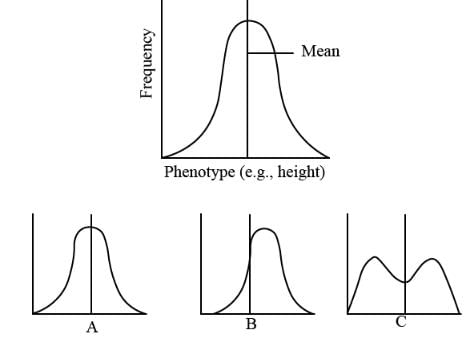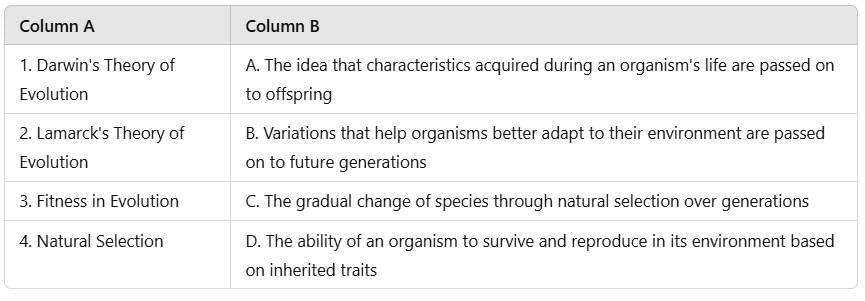Test: Evolution-3 - NEET MCQ
10 Questions MCQ Test Biology Class 12 - Test: Evolution-3
Following is the diagrammatic representation of the operation of natural selection on different traits. Which among the following options correctly identifies all the three graphs A, B and C.




Read the following statements and choose the correct option.
(i) Increase in melanised moths after industrialisation in Great Britain is a proof for Natural Selection
(ii) When more individuals of a population acquire a mean character value, it is called disruption
(iii) Changes in allelic frequency in a population will lead to Hardy-Weinberg equilibrium
(iv) Genetic drift changes the existing gene or allelic frequency in future generations
(i) Increase in melanised moths after industrialisation in Great Britain is a proof for Natural Selection
(ii) When more individuals of a population acquire a mean character value, it is called disruption
(iii) Changes in allelic frequency in a population will lead to Hardy-Weinberg equilibrium
(iv) Genetic drift changes the existing gene or allelic frequency in future generations
Fill up the blanks in the following paragraph by selecting the correct option
When migration of a section of population to another place and population occurs, (i) change in the original as well as in the new population. New genes/alleles are added to the (ii) population and these are lost from the (iii) population. There would be a (iv) if this gene migration, happens multiple times. If the same change occurs by chance, it is called (v). Sometimes the change in allele frequency is so different in the new sample of population that they become a different species. The original drifted population becomes founders and the effect is called (vi).

When migration of a section of population to another place and population occurs, (i) change in the original as well as in the new population. New genes/alleles are added to the (ii) population and these are lost from the (iii) population. There would be a (iv) if this gene migration, happens multiple times. If the same change occurs by chance, it is called (v). Sometimes the change in allele frequency is so different in the new sample of population that they become a different species. The original drifted population becomes founders and the effect is called (vi).

At a particular locus, frequency of allele A is 0.6 and that of allele a is 0.4. What would be the frequency of heterozygotes in a random mating population at equilibrium?
An inter-breeding population of finches became separated geographically, forming two isolated groups. Each group then became subject to different selective pressures. One group was then introduced into the habitat of the other. Which one of the following would determine whether they now formed two distinct species?
Which of the following statements about Darwin's theory of evolution is/are correct?
1. Evolution by natural selection started when cellular life forms with differences in metabolic capability originated on Earth.
2. The rate of appearance of new species is faster in organisms with longer life spans.
3. Fitness is determined by inherited characteristics and is the result of the ability to adapt and get selected by nature.
4. Lamarck believed that evolution occurred through the use and disuse of organs, such as the elongation of giraffes' necks.
Which of the following factors contribute to changes in gene and allele frequencies, leading to speciation?
1. Gene migration or gene flow
2. Genetic drift
3. Mutation
4. Genetic recombination
5. Natural selection
|
78 videos|277 docs|174 tests
|



















